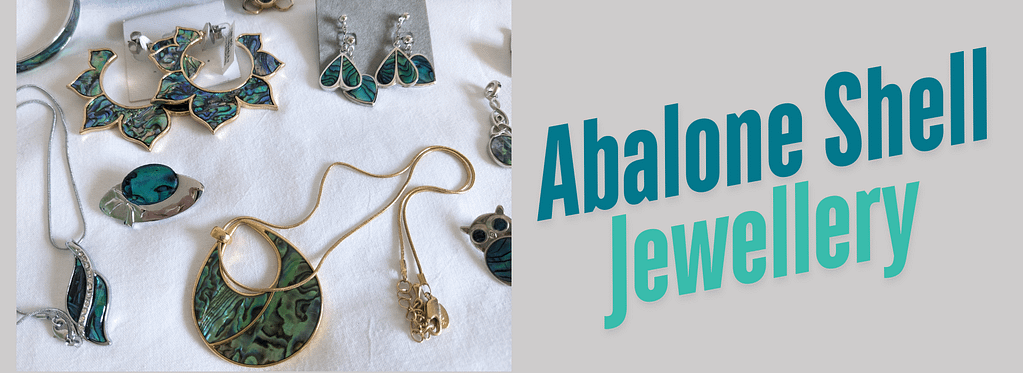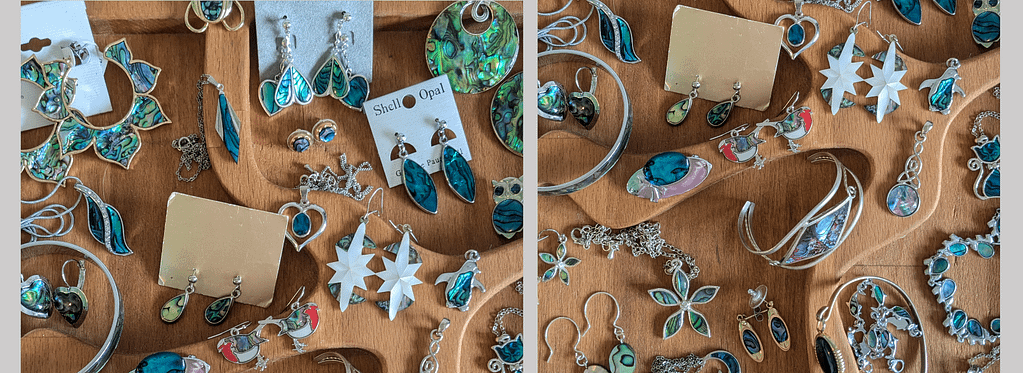
Introduction
Abalone shell is a breathtaking natural material known for its iridescent blues, greens, and purples. Personally, it reminds me of the deep blue sea and I feel connected to the ocean when handling or wearing it. It has been treasured in jewellery-making for centuries, admired not only for its beauty but also for its symbolism and spiritual significance. Whether featured in vintage brooches, rings, or dress clips, abalone shell brings a timeless charm to any collection.
I recently acquired a collection of vintage abalone jewellery and after doing a little research, I wanted to share the following information with you.
What is abalone?
Abalone is an ear shaped shell and the part used in jewellery comes from the inner layer of marine molluscs, primarily species of Haliotis, found in coastal waters worldwide. In the UK we call the creature inside the shell an ormer. Ormers are edible molluscs and the shells become a bi-product of ormers grown as a food source. They grow naturally all over the world and can be found under rocks in shallows surrounding the island where they live. Any ormer taken from the sea must be at least 80mm long. Ormers are also farmed ad grown specifically for their meat.
The shimmering layer, known as nacre, is also what gives pearls their lustre. Due to its natural resilience and captivating colour play, abalone has been widely used in jewellery and decorative arts.
Abalone shell has many names including sea shells, sea ears, nacre, mother of pearl, ormer shells and paua. Paua is the native New Zealand name for abalone shells.
Abalone in vintage jewellery
Throughout history, artisans have incorporated abalone into stunning jewellery pieces:
Mid-Century Mexican Silver – Mexican silversmiths, especially those from Taxco, frequently used abalone in sterling silver designs during the 1940s–1970s.
Boho & Hippie Styles – The 1960s–70s saw a rise in nature-inspired jewellery, where abalone was a favourite material.
Art Deco & Retro Jewellery – Some earlier 1920s–40s designs featured abalone in bold geometric settings, often paired with marcasite or other stones.
Souvenir Jewellery – Many abalone pieces were sold as keepsakes from coastal locations, such as California, Hawaii, and New Zealand.
Symbolism and mystic meanings
Beyond its aesthetic appeal, abalone carries deep symbolic and mystical meanings across cultures:
Emotional Balance & Healing – Thought to have a calming energy, abalone is believed to help soothe emotions, ease anxiety, and promote harmony in relationships. The iridescent colours of the shell radiate soothing energy, helping to calm and balance emotions.
Protection & Strength – In many traditions, abalone serves as a protective talisman against negativity and adversity.
Connection to the Ocean & Water Element – As an oceanic material, abalone is associated with water energy, intuition, and emotional flow.
Spiritual Uses in Indigenous Cultures – Native American tribes and other Indigenous groups use abalone shells in smudging rituals, holding sacred herbs to cleanse energy. Maori culture values pāua (a type of abalone) for its spiritual significance in carvings and jewellery.
Chakra Associations – Abalone is linked to the third eye (intuition) and heart chakra (love & compassion), encouraging self-expression and kindness.
Why choose abalone jewellery
Abalone is not only a visually striking material but also an eco-friendly choice, especially when buying vintage pieces. Choosing abalone jewellery over modern fast fashion accessories supports sustainability by preserving natural resources and reducing waste. Additionally, vintage abalone jewellery often features superior craftsmanship and quality materials that stand the test of time.
It makes a wonderful gift for anyone who loves the ocean and can be found in most jewellery types from rings to necklaces. Due to abalone being a natural material, each piece used in jewellery is unique in shape, colour and appearance.
Taking care of your jewellery
To keep abalone jewellery looking its best:
- Avoid exposure to harsh chemicals or excessive moisture.
- Clean gently with a soft cloth and mild soap if needed.
- Store separately to prevent scratches, as abalone is relatively soft compared to gemstones.
Most importantly, make sure to wear and enjoy your abalone jewellery! Don’t hide it away for special occasions only. Every day is special and it deserves to be worn as often as possible!
Final thoughts
Whether you’re drawn to abalone for its stunning colours, rich history, or spiritual properties, it remains a treasured material in vintage jewellery. If you’re lucky enough to find a beautifully crafted abalone piece, you’re not just wearing jewellery—you’re carrying a piece of the ocean’s magic with you.
Do you have a favourite abalone jewellery piece? Share your thoughts and experiences in the comments!

